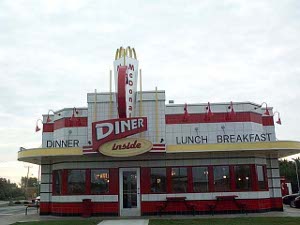 Byron cooling towers
farmed. We wonder what our ancestors would have thought of those cooling towers.
Byron cooling towers
farmed. We wonder what our ancestors would have thought of those cooling towers.
We're sending a picture of nuclear cooling towers we found in the town of Byron, Illinois, close to the Rock River, where some of our ancestors had  Byron cooling towers
farmed. We wonder what our ancestors would have thought of those cooling towers.
Byron cooling towers
farmed. We wonder what our ancestors would have thought of those cooling towers.
As a state with sturdy and steady citizens, Indiana is a popular testbed. The sociology classic, Middletown, was based on Muncie, and now McDonalds has used Kokomo to test their new secret weapon: The Diner (see photo.) When you enter you choose whether to sit in The Diner or order from the counter. We chose The Diner.
Inside is bright chrome and vinyl with tile floors and Fifties'rock. At each table are menus and a bright red telephone. When we picked it up to order we got Muzak and the familiar "Thank you for your patience, one of our representatives will be with you shortly." In fact we got six of those before it rang through to someone.
Then we gave our order and in a few minutes a waiter delivered paper cups  McDonald's Kokomo Diner
for coffee and water, instructing us to fill them up at the self-serve beverage counter. We did that, and pretty soon a waittress brought our meals, on thin plastic plates. We had to go back to the self-serve to get plastic forks and napkins, sweetener and salt packages. They left the bill on the table in one of those big thick padded American Express restaurant bill folders, which we carried up to the Diner cash register.
McDonald's Kokomo Diner
for coffee and water, instructing us to fill them up at the self-serve beverage counter. We did that, and pretty soon a waittress brought our meals, on thin plastic plates. We had to go back to the self-serve to get plastic forks and napkins, sweetener and salt packages. They left the bill on the table in one of those big thick padded American Express restaurant bill folders, which we carried up to the Diner cash register.
The food was McDonalds good and the price was McDonalds right, but the service wasn't that great. They haven't worked the bugs out yet. As we left we noted a number of young workers looking like they'd rather be somewhere else. For a big test marketing project, McDonalds should have picked a restaurant where everybody was Gung Ho!
We decided that on the way out of Kokomo we would treat ourselves to a walk in Highland Park, where we were supposed to see an enormous stuffed steer and an enormous sycamore stump. We never found them, so would the next reader who happens to be in Kokomo please tell us where they are?
 Wrench Barn
Wrench Barn
We had better luck in Muncie, where we found charming, delightful, interesting relatives. Martha and Earl and their daughter Linda, a former librarian (!) made us feel right at home. We traded stories from our growing collection of anecdotes, they fed us a delicious lunch, and we parted with promises to keep in touch.
We moved on to Ohio. As we travel east there are more trucks and more factories, but still plenty of farms, and more farms. And on those farms are beans and corn. Corn and beans. Most of the land in this part of the world is planted in one or the other. Two different shades of green, in alternating fields like a checkerboard.
And if you could accelerate time and snap a picture of this part of the world from the air each year, then the black and white squares of the checkerboard would blink and change colors as the farmers rotated their crops from beans to corn and back again.
We don't know anything about farming, so we kind of sneak in a question  Ottoville Catholic church
here and there. For example, a relative in Illinois told us that it's not time to harvest yet -- the farmers are still selling last year's corn. Some of the farms have many, many silos and storage units.
Ottoville Catholic church
here and there. For example, a relative in Illinois told us that it's not time to harvest yet -- the farmers are still selling last year's corn. Some of the farms have many, many silos and storage units.
But we don't know, so we tell each other the cornsilk is dark enough to harvest. We have learned that a big combine squeezes the ears right off the stalks; we want to see that happening! We argue amiably as we drive about whether they cut the kernels when they put it in the silos, or let the corn dry out first, and when they make corn meal or corn oil, or whether the beans have to flower before they have beans, or whether the holes in the bean leaves are caused by Japanese beetles and if there is a bird that would eat Japanese beetles and anyway if the Japanese beetles damage the bean crop.
In Ottoville, Ohio, we found two interesting sights -- the wrench barn at the Hardly Able Ranch, and the beautiful towering Catholic church, which could have been a cathedral if it was made out of stone instead of brick. With a name like Ottoville, the town must have had a strong German influence.